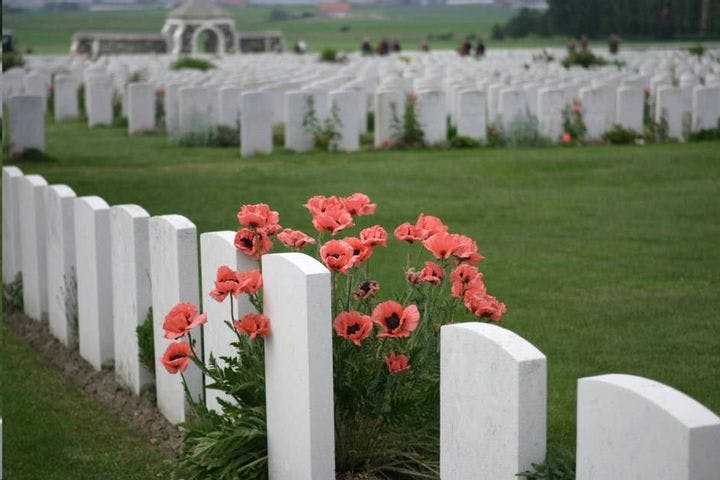Spring 2013
How soldiers got the right to a burial in a cemetery
– The Wilson Quarterly
Until the Civil War, hasty burials on the battlefield were the norm.
For thousands of years, armies afforded few dignities to those who fell on the battlefield. The lowly fighting man “was cast into a hastily dug trench or pit, awarded not even his own grave,” writes Drew Lindsay, executive editor of MHQ: The Quarterly Journal of Military History.
It wasn’t until the Civil War that the U.S. military embraced the notion that a dignified burial in a proper national cemetery was every soldier’s sacred right. But if it weren’t for a popular outcry after World War I, the practice might have been abandoned.
During the Civil War, the United States confronted unprecedented carnage: 750,000 men died, their bodies blanketing battlefields at Shiloh, Antietam, and elsewhere. The conflict was different in another way: Unlike most wars of the past, this one was fought, for the most part, by citizens motivated by deeply held beliefs; few of the soldiers were professionals, Lindsay explains in MHQ. Citizen-soldiers seemed to deserve more than a rude battlefield grave.
Whether fighting for North or South, young soldiers saw their fallen comrades’ bodies left to the elements, “without a kind hand to hide one’s remains from the eye of the world or the gnawing of animals or buzzards,” one wrote in horror. Compounding their revulsion were new, more sentimental ideas about death that had become influential in a midcentury American culture increasingly taken with romanticism. American Protestants, in particular, embraced the ideal of the “Good Death,” characterized by “dignity and grace.” The modern battlefield hardly offered that.
In 1862, President Abraham Lincoln gave in to popular pressure and authorized the construction of national cemeteries for Union fighting men. After the war, Montgomery C. Meigs, the U.S. quartermaster general, sent troops fanning out to battlefields throughout the country to uncover forgotten gravesites. They persisted for five years, recovering the remains of 316,000 of the 342,000 men who had sacrificed their lives for the Union. The dead were reburied at 74 national cemeteries, including — thanks to the wily Meigs — one on the site of Confederate general Robert E. Lee’s estate in Virginia, which became Arlington National Cemetery. (There was no systematic effort to recover Confederate soldiers’ remains.)
Three decades later, at the end of the Spanish-American War, President William McKinley, who had been deeply affected by his own experience as a young soldier at Antietam, swiftly ordered the dead brought home from foreign battlefields. The New York Times called McKinley’s mandate an “innovation in the world’s history of warfare.”
But World War I was different. By the war’s end, in 1918, the United States had lost more than 70,000 men on a foreign continent. They lay in hastily prepared graves. Families had clamored from the outset for the return of those killed. General John “Black Jack” Pershing, commander of the American Expeditionary Force in Europe, said that was impractical, adding that family members should be spared from seeing the horrific wounds inflicted by modern warfare. After the armistice, America’s European allies vociferously opposed the idea of exhuming the bodies. French leaders wanted to get on with reconstruction without being distracted by having to run “ghoulish trains packed with bodies” across the country. The British government worried that an American effort would fuel public pressure at home for a costly effort to repatriate the British dead — the bodies of a staggering 700,000 men.
Some Americans found the battlefield graves fitting. American pilot Quentin Roosevelt, former president Theodore Roosevelt’s son, had died in 1918 after being shot down over France. Theodore and Edith Roosevelt said their son should remain where he fell: “To us it is painful and harrowing long after death to move the poor body from which the soul has fled.” But most grieving American families demanded otherwise. “My son sacrificed his life to America’s call, and now you must as a duty of yours bring my son back to me,” a New York mother wrote, addressing the government.
The War Department relented in October 1919, almost a year after the end of the war. The families of every fallen soldier would be given two choices: proper burial of their loved one in new American military cemeteries in Europe, or the return of remains to America’s shores. The families of some 30,000 fallen soldiers opted for European burial, while another 46,000 of the dead were brought home.
Some Americans found the whole business gruesome. And foreigners scoffed at the U.S. effort. “America feels that she is morally superior to Europe,” British writer Stephen Graham declared after viewing stacks of caskets bound for the United States. “American soil is God’s own country and the rest is comparatively unhallowed.”
“But a sacred tradition had been born,” Lindsay writes, and other countries have followed the American example, including Britain, which brought home its dead after the Falklands War with Argentina in 1982.
THE SOURCE: “Rest in Peace?” by Drew Lindsay. MHQ: The Quarterly Journal of Military History, Winter 2013.
Photo courtesy of The U.S. Department of Defense
